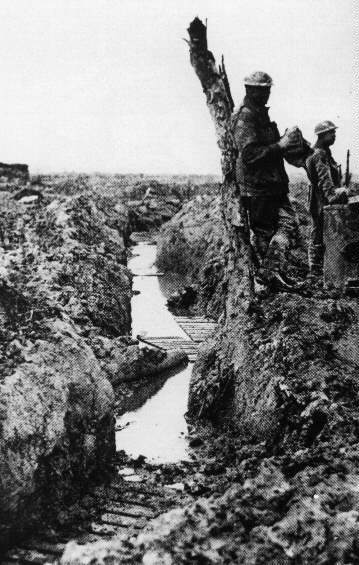Mud and trenches often are the first things that come to mind when picturing World War I.
We remember the bloody horrors of gas and the unbelievable casualties, but the photos always remind us of trenches full of mud.
It started in Belgium in the first days of August 1914.
Germany surprised the world when instead of marching straight into France, it took a hail Mary trip into neutral Belgium in a move known as the Schlieffen Plan.
The secret strategy, devised a decade before, had the German army marching through Belgium and into the less heavily defended northwestern quadrant of France with the goal of taking Paris.
They had to move quickly, but had the plan worked, Germany could have taken control of France within a short period of time.
The heroic actions of King Albert of Belgium foiled their movement.

Passchendaele, France (Wikipedia)
King Albert ordered the destruction of the dikes in Flanders, thus allowing seawater to invade the prime agricultural lowlands of his country.
Flooding over the land and a high water table produced thick, sucking, sludgy mud in the clay or sandy soil.
The British Expeditionary Forces mobilized quickly and were on hand to stop the German army.
Everyone dug trenches.
Into the mud.
Stalemate
No one was prepared for it.The Germans had expected to sweep into Paris. The British had trained on the Salisbury Plain where it rained, but the water table was not so high.
No one expected the stalemate that caused them to dig in so far. Everyone expected to be home by Christmas, their enemies defeated.
Instead, millions of men wallowed in the mud, frequently knee deep, for more than four years.
Here’s an excellent examination of the horrors: Muddy Hell.
To avoid the sharp shooters on the other side, soldiers had to keep their heads down.
They lived in caves burrowed in the sides of the trenches. When it began to rain, the water had no where to go but along the bottom of the trench, forming deep, sucking mud.
Remedies included duck board laid out in the trenches, waterproof boots, trench coats, putties, changes of socks and frequent rotation to the rear. It was impossible not to get–and stay–muddy while facing “no man’s land.”
Days of feet not drying out frequently resulted in “trench foot,” a disabling condition that if not treated resulted in blackened limbs and dead skin–often leading to more debilitating ailments like gangrene.
German side
The German army had it a little better. They tended to hold the higher ground and they dug in for the long haul–building trenches that involved complex engineering that helped keep them dry.
The BEF and the French armies generally built their trenches as temporary complexes and didn’t devote time, energy or money into making them habitable, particularly in Flanders.
No Man’s Land itself, filled with craters caused by enemy artillery from both sides. Deep holes dotted the landscape and quickly filled with the same muddy water.
Far too often, men slipped into the holes as they traversed No Man’s Land in the dark. Weighed down by their weapons and many’s inability to swim meant thousands of soldiers simply disappeared into the muddy pools of water that collected.
The nightmares never ended.
Harry Patch, the final WWI soldier to die, described it this way:
“Life in the trenches was dirty, lousy, unsanitary. The barrages that preceded battle were one long nightmare. And when you went over the top, it was just mud, mud and more mud. Mixed with blood. You struggled through it, with dead bodies all around you.
Any one of them could have been me.”
He survived until 2009, age 111.
 For more than enough photos of muddy trench misery and WWI, check out my WWI shots Pinterest board.
For more than enough photos of muddy trench misery and WWI, check out my WWI shots Pinterest board.
Tweetables
Mud and trenches: emblems of WWI. Click to Tweet
The misery of muddy trench warfare. Click to Tweet
King Albert saves France; but mud and trenches remain. Click to Tweet






Thoughts? Reactions? Lurker?